
Varaha is the avatar of the Hindu god Vishnu, in the form of a boar. Varaha is generally listed as third in the Dashavatara, the ten principal avatars of Vishnu.

Hiranyaksha, also known as Hiranyanetra was an oppressive Asura who attacked the heavens and thereafter kidnapped and attempted to destroy the earth goddess in Hindu mythology.

An avatar, a concept in Hinduism that means "descent", is the material appearance or incarnation of a deity on earth. The relative verb to "alight, to make one's appearance" is sometimes used to refer to any guru or revered human being.
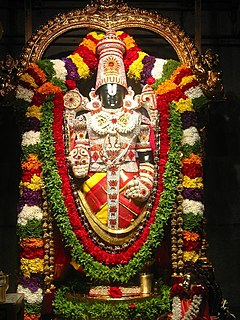
Lord Venkateshwara, also known as Śrīnivāsa, Bālājī, Vēṅkateswara, Venkata Ramana, Yedukondalavasa, Aapadamokkulavadu,Thirupathy Timmappa, Ezhumalaiyaan, Malaiyappa swamy and Govindha, is a form of the Hindu god Maha Vishnu. Lord Venkateswara is the presiding deity of Tirumala Venkateswara Temple located in Tirupati, Andhra Pradesh, India.

Srirangapatna is a town of Mandya district in the Indian State of Karnataka. Located near the city of Mysore, it is of religious, cultural and historic importance.

Ranganāthar, also known as Sri Ranganatha, Aranganathar, Ranga and Thenarangathan, is a Hindu deity, more well known in South India, and the chief deity of the Sri Ranganathaswamy Temple, Srirangam. The deity is a resting form of Lord Vishnu, recumbent on the great form of the serpent god Adisesha, one of the foremost of Hindu gods. His consort is Goddess Lakshmi, also known as Ranganayaki. His two other consorts seen next to his recumbent figure are Bhudevi and Nila Devi. Most of the deities portray a 'smiling' lord in a sleeping or reclining position over the celestial serpent Adisesha in the sea of cosmic dissolution (pralaya). This is the form in which he is open to listening to all of his devotees' woes, and blesses them. Apart from being worshipped by all Hindus, this form is of particular importance to the Sri Vaishnava community. His name in Sanskrit means "leader of the place of assembly", coined from two Sanskrit words ranga (place) and natha.

Sri Varaha Lakshmi Narasimha temple, Simhachalam is a Hindu temple situated on the Simhachalam Hill Range, which is 300 metres above the sea level in Visakhapatnam, Andhra Pradesh. It is dedicated to Vishnu, who is worshipped there as Varaha Narasimha. As per the temple's legend, Vishnu manifested in this form after saving his devotee Prahlada from a murder attempt by the latter's father Hiranyakashipu. Except on Akshaya Trutiya, the idol of Varaha Narasimha is covered with sandalwood paste throughout the year, which makes it resemble a linga.

Sharabha or Sarabha is a part-lion and part-bird beast in Hindu mythology, who, according to Sanskrit literature, is eight-legged and more powerful than a lion or an elephant, possessing the ability to clear a valley in one jump. In later literature, Sharabha is described as an eight-legged deer.
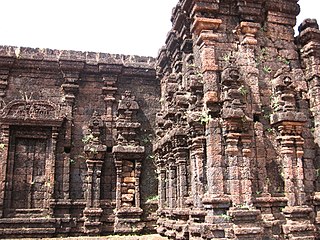
The Rajarajeswara temple is a Shiva temple located in Taliparamba in Kannur district of Kerala, South India. The temple is regarded as one of the existing 108 ancient Shiva Temples of ancient Kerala. It also has a prominent place amongst the numerous Shiva temples in South India. It had the tallest shikhara amongst the temples of its time. The Rajarajeshwara temple has a top of about 90 tonnes. If any problem is encountered in the other temples of South India, devotees seek a solution in this temple through a prasna, a traditional method of astrological decision making. The prasna is conducted on a peedha outside the temple.

Lakshmi Narayana or Lakshmi-Narayana, also sometimes spelled Lakshminarayan, Lakshminarayana, Laxminarayana, is a manifestation of Vishnu in the Hindu religion. It is usually referring to Vishnu, also known as Narayan, when he is with his consort, Lakshmi, in his abode, Vaikuntha. The goddess of beauty Lakshmi is depicted as standing next to a dark-skinned Vishnu, who is holding a conch, mace, lotus and the Sudarshana Chakra. Another depiction of Lakshminarayan portrays Lakshmi in the service of Narayan, who is reclining on the cosmic serpent Sesha, floating in Kshīrsagār, the Ocean of Milk.

Nimishamba is the name of a temple on the banks of the Cauvery river, located about 2 km from Srirangapattana on the road leading to Sangam (confluence) in the south Indian state of Karnataka.

Venkateswara Temple is a Hindu temple situated in the hill town of Tirumala at Tirupati in Chittoor district of Andhra Pradesh, India. The Temple is dedicated to Venkateswara, a form of Vishnu, who is believed to have appeared here to save mankind from trials and troubles of Kali Yuga. Hence the place has also got the name Kaliyuga Vaikuntham and the Lord here is referred to as Kaliyuga Prathyaksha Daivam. The temple is also known by other names like Tirumala Temple, Tirupati Temple, Tirupati Balaji Temple. Venkateswara is known by many other names: Balaji, Govinda, and Srinivasa.The temple is run by body Tirumala Tirupati Devasthanams (TTD) which is under direct control of Andhra Pradesh Government. The head of TTD is appointed by Andhra Pradesh Government. The revenue from this shrine is used by Andhra Pradesh government.

The Ranganthaswamy temple in Srirangapatna, in the Mandya district of Karnataka state, India, is dedicated to the Hindu god Ranganatha. It is one of the five important pilgrimage sites of Sri Vaishnavism along the river Kaveri for devotees of Ranganatha. These five sacred sites are together known as Pancharanga Kshetrams in Southern India. Since Srirangapatna is the first temple starting from upstream, the deity is known as Adi Ranga. The town of Srirangapatna, which derives its name from the temple, is located on an island in the river Kaveri.
Tirumala Sri Venkateswara Temple at Tirupati in the Indian state of Andhra Pradesh is the most famous Vaishnavite temple in the world. The presiding deity of Vishnu here is referred to as Venkateswara. There are many legends regarding this temple. Sri Venkatachala Mahatyam is the most accepted legend among these, which provides the history of the temple across the various yugas. This place had also been mentioned in many puranas. It has been said as "Venkatadri samasthanam Brahmande nasti kinchana, Venkatesha samodevo na bhuto na bhavishyati" which literally translates as There is no place in the entire Universe which is equal to Tirumala and there is no other God equal to Venkatesha in the past, present or will be in the future.
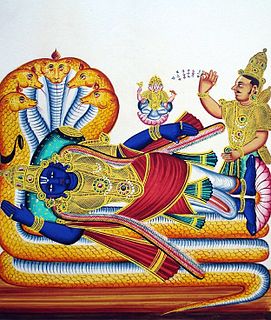
Pancharanga Kshetrams or Pancharangams is a group of five sacred Hindu temples, dedicated to Ranganatha, a form of the God Vishnu, on the banks of the Kaveri River. The five Pancharanga Kshetrams in the order of their successive locations, on the banks of the Kaveri River are: The Srirangapatna called the Adi Rangam, the first temple on the banks of the Kaveri River from the upstream side; the Srirangam in Tamil Nadu known as Kasthuri Rangam or Anthya Rangam, Appalarangam or Koviladi at Tiurppernagar in Tamil Nadu, Parimala Ranganatha Perumal Temple at Tiruindalur in Mayiladuthurai or Mayuram and Vatarangam near Sirkazhi, also listed as Sri Renganatha Perumal Temple, Vadarengam, Tamil Nadu, 609108.
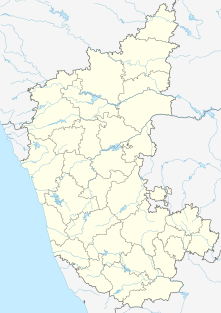
Bettadapura is a town located in Mysore district, in the Indian state of Karnataka. The name is derived from two Kannada words, "Betta" and "pura". Betta means "hill" and pura means "town".
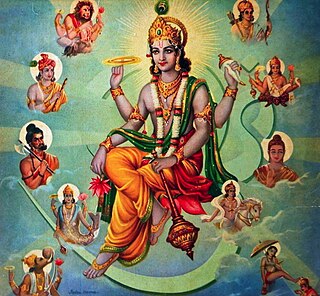
The Dashavatara refers to the ten primary incarnations (avatars) of Vishnu, the Hindu god of preservation which has Rigvedic origins. Vishnu is said to descend in the form of an avatar to restore cosmic order. The word Dashavatara derives from daśa, meaning 'ten', and avatar, roughly equivalent to 'incarnation'.
Chittampara is a village in Idukki district, Kerala, India.

Sri Venkateswara Mahatmyam is 1960 Indian Telugu-language Hindu mythological film directed by P. Pullaiah and produced by V. Venkateswarlu under the Padmasri Pictures banner. It is based on the Venkateswara avatar of Vishnu at Tirumala. It stars N. T. Rama Rao, S. Varalakshmi, and Savitri in the lead roles and music composed by Pendyala Nageswara Rao. The film was dubbed into Tamil and released as Srinivasa Kalyanam.

Sri Tirupati Venkateswara Kalyanam is a 1979 Indian Telugu-language Hindu mythological film, based on Lord Venkateswara Avatar at Tirumala, produced and directed by N. T. Rama Rao under his Ramakrishna Cine Studios banner. It stars N. T. Rama Rao, Jaya Prada, Jayasudha, Nandamuri Balakrishna in the lead roles and music composed by Pendyala Nageswara Rao.



















